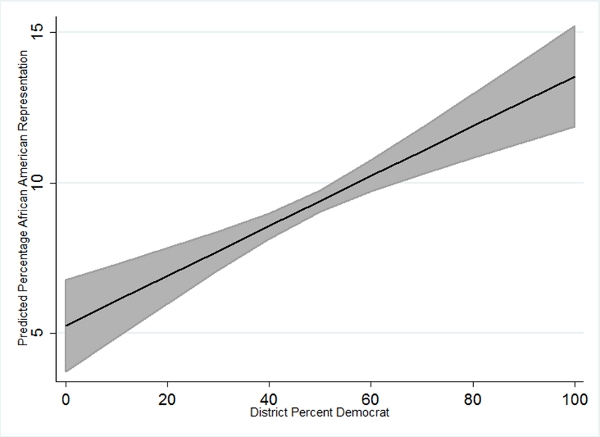
 Research on electoral structure has often touted single member districts to be beneficial for achieving minority representation. In a study of a national sample of school board elections between 2002 and 2008, Kenneth J. Meier and Amanda Rutherford find an unanticipated trend—African Americans are now over-represented on school boards with at-large elections when they are a minority of the population. They argue that partisanship changes the relationship between electoral structure and race so that African American may benefit in counties with a majority Democrat constituency. The traditional pattern of African-American under representation occurs only in school districts with a Republican voting majority.
Research on electoral structure has often touted single member districts to be beneficial for achieving minority representation. In a study of a national sample of school board elections between 2002 and 2008, Kenneth J. Meier and Amanda Rutherford find an unanticipated trend—African Americans are now over-represented on school boards with at-large elections when they are a minority of the population. They argue that partisanship changes the relationship between electoral structure and race so that African American may benefit in counties with a majority Democrat constituency. The traditional pattern of African-American under representation occurs only in school districts with a Republican voting majority.
In a 5-4 vote, the Supreme Court recently invalidated a portion of the 1965 Voting Rights Act by allowing states with a history of discrimination to change election laws without obtaining federal approval. The closely divided vote reflected disagreement over whether minorities continue to face barriers in elections. The effects of this ruling were felt immediately. Following the decisions, the state of Texas announced that it would implement a voter identification law; several other states have followed suite in considered similar policy changes and several local governments have proposed changes in electoral districts.
Since the Voting Rights Act was passed, scholars have studied whether electoral structures matter in helping or hindering the descriptive representation (where elected representatives represent the characteristics of their constituencies as well as their preferences) of minority groups. This research has primarily taken place at the local level, the only level of government with multiple electoral structures. At-large systems elect all representatives from an entire jurisdiction while ward or single-member districts divide a jurisdiction into smaller units in which candidates run for a single seat. Single-member districts have largely been linked to higher levels of representation for minorities because the use of districts may allow minorities to constitute a majority of voters for one or more seats in the jurisdiction.
In the U.S., nearly sixty five percent of school board elections use at-large systems while thirty five percent operate as single-member districts. Studying U.S. school board elections in 2002, 2004, and 2008 for school districts with over 5,000 students, we find that African Americans are overrepresented, on average, in at-large districts when African Americans are a minority of a population. This relationship is largely unprecedented given the strong theoretical reasons for underrepresentation.
What underlying factors might theoretically be driving this observed overrepresentation? We tested whether the differences in representation between the two electoral structures were driven by the racial distribution of students in schools, the voting age population, prior successful black school board candidates, coalitions with Latinos, and the presence of noncitizens. However, none of these factors altered our finding.
If we view electoral structures as simply a set of rules with biases, the logical way to overcome these biases, in theory, is to create a bloc of candidates to run together or to create a coalition to support a single candidate. Who might have an incentive to put together a slate of candidates or a coalition? One possibility is the Democratic Party, a political group interested in gaining additional African American votes. Though school board elections are nominally nonpartisan, where the Democratic Party constitutes a voting majority in a school district, they have an incentive to build stronger ties with African Americans to foster electoral support to win elections other than the school board.
Our results support this logic– Democratic majorities drive African American overrepresentation in at-large districts (see Figure1). In majority Democratic school districts, we find that African American gain significantly more representation in at-large elections while they are neither over nor underrepresented in single-member district elections. In such jurisdictions, African Americans attain approximately 120 percent of the representation that their population would warrant proportionately. In majority Republican Districts, electoral structure does not make a difference, and African Americans are somewhat under represented (although not statistically so). Thus, partisanship can be a salient factor in securing representation for African Americans in systems where they have been traditionally underrepresented.
Figure 1: Expected Percentage of African American School Board Representation as District Democrat Increases

Figure 1 shows the impact of Democratic voting controlling for other factors including the size of black population. This added representation from partisanship illustrates how Democratic voting enhances the ability of African Americans to translate their numbers into actual representation.
For many, the primary goal of achieving descriptive representation is to enhance substantive representation, whereby minority representatives act in the interest of the group they represent (thus achieving some type of policy benefit for this group). While our study suggests that greater descriptive representation can be achieved in majority Democrat at-large districts that does not necessarily mean that at-large districts facilitate substantive representation. Future research studies probe this question and we find that substantive representation may actually be stronger in single member districts. Thus, the benefit of single member districts for minority policy outcomes cannot be overlooked. Even still, if policies related to voting structures and minority language assistance in the Voting Rights Act continue to be challenged; the relationship between electoral structures needs to consider the local political context. At-large elections are majoritarian political structures. How African Americans fare in such systems depends on the political support for incorporating African American representation, in this case illustrated by the policy interests of the Democratic Party.
This article is based on the paper ‘Partisanship, Structure, and Representation: The Puzzle of African American Education Politics” in the American Political Science Review.
Featured image credit: RR Andersson (Creative Commons BY SA)
Please read our comments policy before commenting.
Note: This article gives the views of the author, and not the position of USApp– American Politics and Policy, nor of the London School of Economics.
Shortened URL for this post: http://bit.ly/TmBFpe
_________________________________________
About the authors
 Kenneth J. Meier – Texas A&M University
Kenneth J. Meier – Texas A&M University
Professor Meier is the Charles H. Gregory Chair in Liberal Arts at Texas A&M University. He also directs the Project for Equity, Representation and Governance, the Texas Educational Excellence Project, and the Carlos Cantu Hispanic Education and Opportunity Endowment and holds a joint appointment as a professor of public management at the Cardiff University School of Business (Wales). Professor Meier’s research is characterized by a multi-disciplinary approach that combines both empirical and normative questions. He uses institutional theories of politics applied to a wide range of substantive issues to determine who gets what, when and how.

Amanda Rutherford – Texas A&M University
Amanda Rutherford is a PhD student in the Department of Political Science at Texas A&M University. Her research focuses on public management, public administration, and representative bureaucracy largely in the context of education policy.






